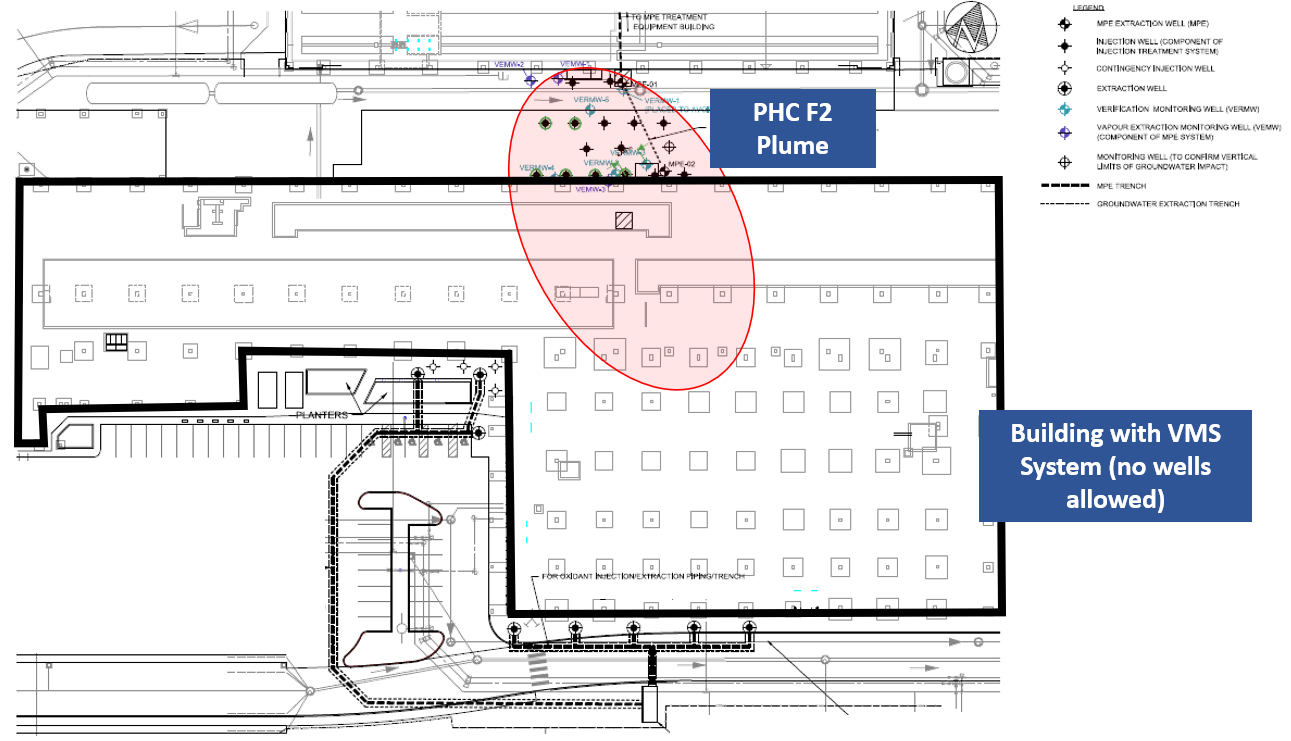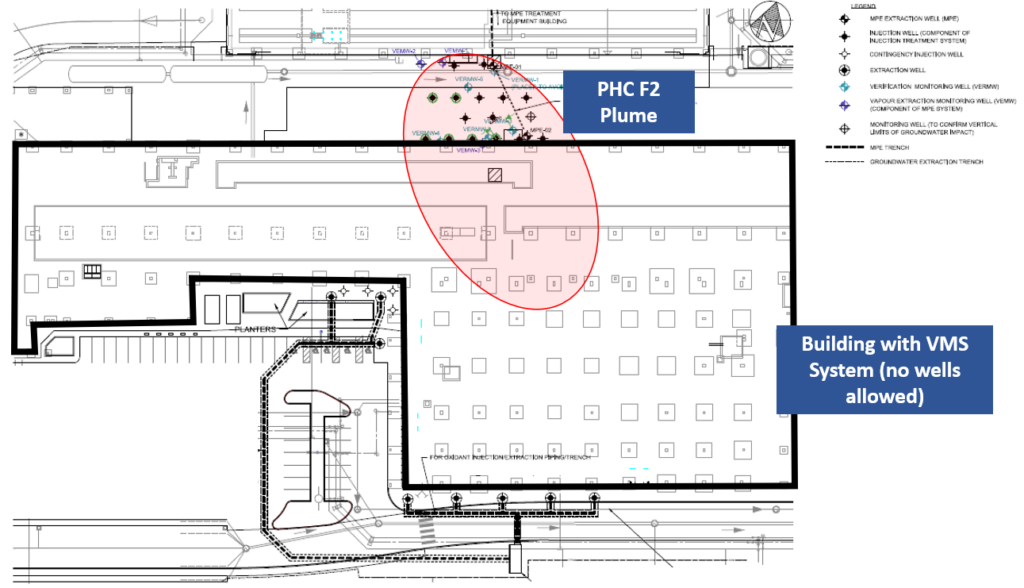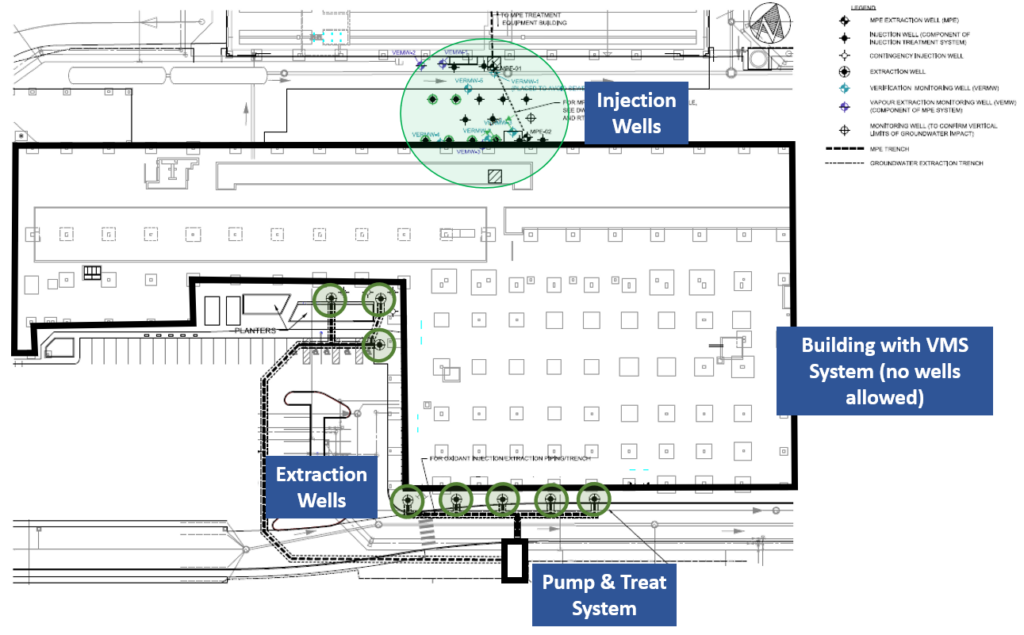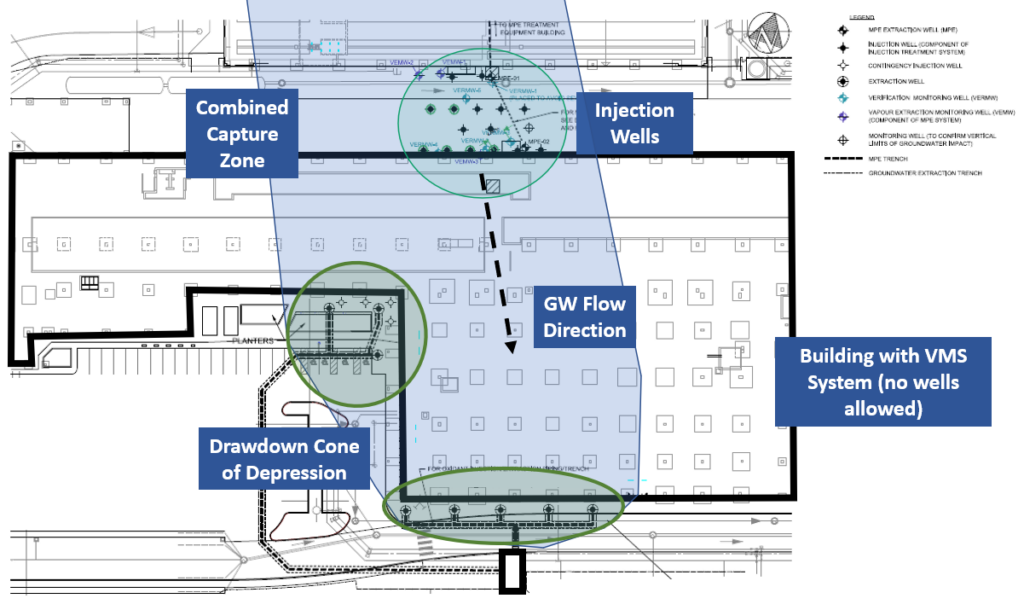
Overview
The following case study is a good example of how a Pump & Treat system was used to enhance the natural hydraulic gradients at a site to effectively pull chemical oxidants across an otherwise inaccessible area and facilitate the destruction of a plume of petroleum hydrocarbons (PHCs) located beneath a building.
Background
A large property in the GTA had PHCs impacts from former industrial activities. A Risk Assessment was completed to support redevelopment of the property and Property Specific Standards (PSS) were developed. A PHC F2 plume with concentrations in exceedance of the PSS for PHC F2 was identified over a 1,680 m2 area.
Geology at the site was generally silty sand to sandy silt with an underlying silty clay till confining layer at 16 meters below ground surface (mbgs). The water table depth ranged from 10.5 to 11.3 mbgs. The source area of the plume (450 m2) was in an accessible area on the site, however, the majority of the plume (1,230 m2) extended under a downgradient building. The downgradient building was completely inaccessible to injection or extraction locations due to a Risk Assessment which required a Vapour Mitigation System (VMS) that did not allow any penetrations within the building footprint.

Figure 1 – Site Plan showing approximate PHC F2 plume location and Building with VMS System
Remedial Approach
There were a number of challenges that made this site particularly challenging:
- The majority of the plume was located under an inaccessible building;
- The plume was very deep at >10 mbgs; and
- The work was to occur on an active construction site with many access constraints and coordination issues.
Vertex worked closely with the consultant to develop a multi-technology remedial plan to address the PHC F2 plume via Pump & Treat (P&T) enhanced In-Situ Chemical Oxidation (ISCO). A gallery of 15 injection wells were installed in the upgradient plume source area to facilitate the delivery of chemical oxidants to the subsurface. A series of 8 extraction wells were installed on the south side of the building and trenched over to a P&T system which pre-treated the groundwater prior to discharge to a sanitary sewer. The chemical oxidant Klozur® SP (sodium persulfate) was selected because of its ability to treat PHC F2 and its typical persistence in the subsurface of 6 to 8 weeks, so the P&T system could pull it underneath the building.

Figure 2 – Site Plan except showing Injection Wells, Extraction Wells, and P&T System location
Results
To start, a Tracer Test was completed to assess the P&T system’s ability to pull amendments and PHCs through the target treatment zone. A total of 89,600 L of solution containing a low-level conservative tracer was injected at the north side of the building. The Pump & Treat system was operated at 30,000 L/day for a period of two weeks prior to the tracer injection, and eight weeks after the tracer injection. A total of 1,862,000 L was ultimately extracted. Tracer solution was observed at the closest extraction wells (located 45 m) from the injection area after three weeks, indicating that the Pump & Treat system was capable of pulling amendments under the building within the expected persistence of the Klozur SP oxidant (i.e., six to eight weeks).

Figure 3 – Site Plan showing Tracer Test interpreted Drawdown Cone of Depression and Capture Zone
Following the successful Tracer Test, a series of chemical oxidation events were completed. Oxidant Injection Event #1 consisted of 90,000 L of alkaline activated Klozur® SP solution into the upgradient injection wells, coupled with downgradient extraction from the P&T system. During the first injection event, persulphate was detected at four of eight extraction wells (located 45 to 75 m away) after approximately three weeks. The P&T system was then shutdown to avoid extracting oxidant and to allow the oxidant to remain in the subsurface to react with PHC impacts.
Confirmatory sampling was completed by the consultant after the oxidant injection event. Based on these results, modifications were made to the injection program loading rates, and how the P&T system was operated (i.e., less aggressive pumping rates) to increase oxidant contact time in the target zone beneath the site building.
Conclusion
Complicated sites have no easy answers; however, leveraging multi-technologies, in combination with an adaptable and innovative team, provides the best chance at remedial success. In this case, a P&T system was successfully used to enhance delivery of Klozur® SP oxidant beneath a building with restricted surface access over a downgradient distance of 45 to 75 m. Remediating the impacted zone would otherwise have been nearly impossible.

